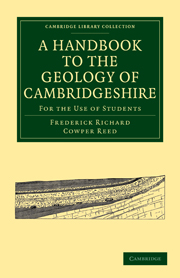THE CRETACEOUS BEDS
Published online by Cambridge University Press: 05 July 2011
Summary
The greater part of Cambridgeshire is occupied by beds belonging to this system, though concealed over large tracts by Post-Tertiary deposits. The Lower Greensand forms its basement bed. The Upper Chalk above the Zone of Micraster cor-testudinarium has been completely removed by denudation.
The “Cambridge Greensand” is of special interest, but the peculiar characters of the Lower Greensand, the change in the Gault when traced northward, and the rock-beds in the Chalk are all worthy of particular attention.
THE LOWER CRETACEOUS.
THE LOWER GREENSAND.
General remarks. The lowest beds of the Lower Greensand are entirely absent in England, and in our district only that part which is held to correspond to the very uppermost part of the Aptian of the Continent is present at all. In the Midlands and the eastern part of England the so-called Lower Greensand represents only the higher divisions of the Lower Greensand of the south and south-eastern counties. It is not believed to include any part of the Neocomian of D'Orbigny. For this reason it seems undesirable to introduce that term at all into English Geology, especially in view of its different applications on the Continent and the many points of dispute connected with it.
Relation to underlying and overlying beds. As in the midland district, the Lower Greensand in the eastern counties rests unconformably on the Upper Jurassic rocks which prior to its deposition had suffered considerable erosion.
- Type
- Chapter
- Information
- A Handbook to the Geology of CambridgeshireFor the Use of Students, pp. 47 - 152Publisher: Cambridge University PressPrint publication year: 2009First published in: 1897



